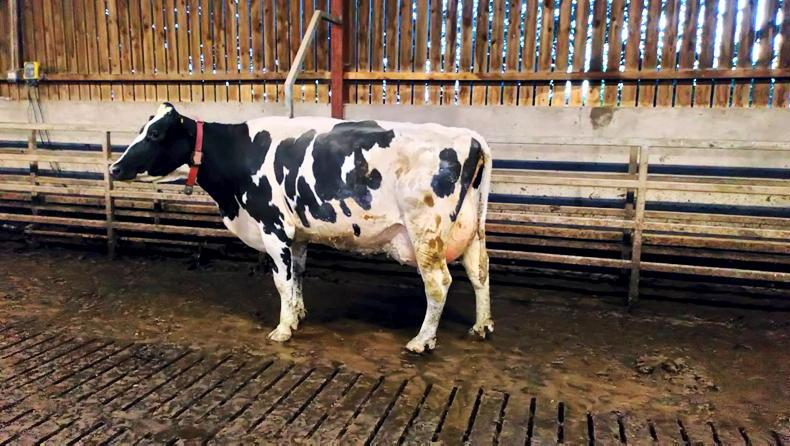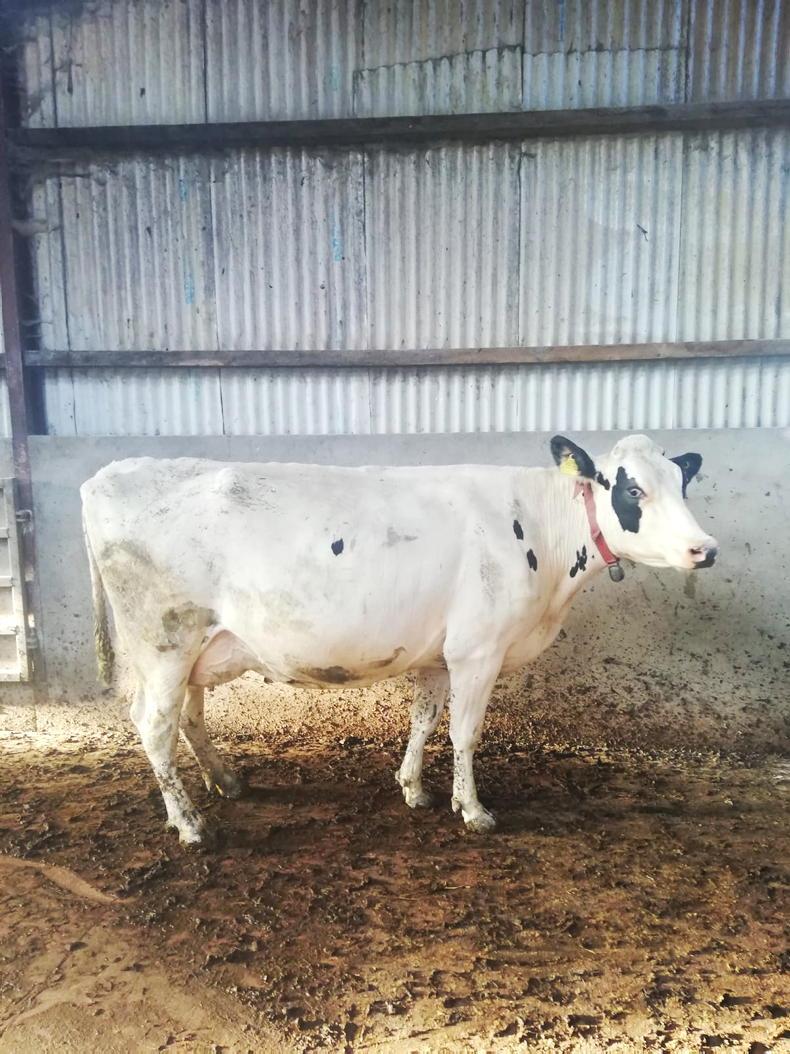The main breeding aim on James and Owen Martin’s farm is to lift butterfat and protein levels while holding milk yields.
The Martins milk 160 Holstein cows near Dromintee, Co Armagh, in a fully housed system. The herd calves year-round and the latest figures show average milk yield is 9,685l at 3.88% butterfat and 3.24% protein.

Cow 4858.
To get a good understanding of the genetics that James is after, he picks out two cows that he considers optimal for his system.
Cow 4858 is in her second lactation and had a 305-day yield last year of 10,524kg at 4.52% butterfat and 3.32% protein.
She is recently back in-calf to sexed semen and is functional, so we do not really notice her in the herd
“She is my type of cow, giving that sort of milk yield from that butterfat and protein,” James explained.
“She is a healthy cow and is good on her feet and legs. She is recently back in-calf to sexed semen and is functional, so we do not really notice her in the herd. She is able to come in and do the business every day with no fuss,” he said.
Cow 4858 also has favourable breeding indices, which are under the UK-based profitable lifetime index (PLI) system. Her overall PLI of £149 is well above the herd average of £92. She has positive predicted transmitting ability (PTA) for butterfat (+0.06%), protein (+0.03%) and milk (+190kg).
Cow 4953
Another example of an ideal cow for the Martin herd is cow 4953. This first-lactation heifer is 298 days in milk and has yielded an impressive 11,215kg at 4.60% butterfat and 3.06% protein.
“She has given a fantastic amount of milk for her first lactation. She had two services and went back in-calf to sexed semen,” James said.

Cow 4953.
Cow 4953 has good butterfat levels and this is reflected in her PTA for butterfat of +0.08%. Probably the only issues that James has with her are low protein levels and her PTA for protein of -0.03%.
With such a high yield in the first lactation, is James confident that cow 4953 will have longevity?
“She is in brilliant condition, with good feet and legs and she has a nice tight udder. To me, she is the type of cow that will last, if you manage her right. That is the sort of cow we are trying to breed,” he responds.
Breeding priorities
Despite James having a strong focus on milk yields, high PTA for milk is no longer a priority when selecting sires. This is because genetics is not the limiting factor on milk yields on the Martin farm anymore.
If anything, milking frequency is probably the main factor holding back milk output, but James is clear that he does not want to start milking cows three times a day.
The exercise found no correlation between milk PTA and actual milk yield
The outlined figures for cow 4858 and cow 4953 reflect previous analysis of the entire Martin herd, which found that cows with higher breeding indices for butterfat and protein delivered in terms of actual milk components in the bulk tank. The exercise found no correlation between milk PTA and actual milk yield.
The analysis also shows that the current breeding strategy of selecting sires for milk components delivers results in the performance of progeny. See more at www.ifj.ie/dairylink.
Reviewing fodder stocks and feed plans
With cows housed all year, silage is a fundamental part of James Martin’s dairying system.
An updated fodder budget by Dairylink adviser Aidan Cushnahan found that there is enough silage on the Martin farm to last the milking herd and 25 dry cows at least eight months and young stock five months.
A summary of silage analysis for the 2020 fodder campaign is outlined in Table 1.
Results for first-cut reflect the excellent weather conditions in May. Weather was difficult for later cuts, which led to delayed harvesting and lower energy (ME) values.
The milking herd is split in two feed groups
To address this, the Martins are mixing first- and second-cut silage for the lactating groups on the farm, while third-cut silage is being allocated to heifer replacements and dry cows.
The milking herd is split in two feed groups. The high yielders are offered 40kg of silage, 6kg of a 24% crude protein blend and 4kg of caustic wheat.
This diet is designed for maintenance plus 28l and cows are topped up with a 17% crude protein nut in a feed-to-yield system in the parlour.
The low-yielding group are on 42kg of silage, 3kg of blend and 2.5kg of caustic wheat. This ration covers maintenance plus 18l and all cows in this group are offered 1kg of concentrate in the parlour on a flat-rate basis.
Dairylink farmers are taking a mid-winter review of fodder budgets.Heat detection and breeding continues in autumn-calving herds.Autumn-born calves are being weaned.Spring-calving farmers are drying cows off at present.
The main breeding aim on James and Owen Martin’s farm is to lift butterfat and protein levels while holding milk yields.
The Martins milk 160 Holstein cows near Dromintee, Co Armagh, in a fully housed system. The herd calves year-round and the latest figures show average milk yield is 9,685l at 3.88% butterfat and 3.24% protein.

Cow 4858.
To get a good understanding of the genetics that James is after, he picks out two cows that he considers optimal for his system.
Cow 4858 is in her second lactation and had a 305-day yield last year of 10,524kg at 4.52% butterfat and 3.32% protein.
She is recently back in-calf to sexed semen and is functional, so we do not really notice her in the herd
“She is my type of cow, giving that sort of milk yield from that butterfat and protein,” James explained.
“She is a healthy cow and is good on her feet and legs. She is recently back in-calf to sexed semen and is functional, so we do not really notice her in the herd. She is able to come in and do the business every day with no fuss,” he said.
Cow 4858 also has favourable breeding indices, which are under the UK-based profitable lifetime index (PLI) system. Her overall PLI of £149 is well above the herd average of £92. She has positive predicted transmitting ability (PTA) for butterfat (+0.06%), protein (+0.03%) and milk (+190kg).
Cow 4953
Another example of an ideal cow for the Martin herd is cow 4953. This first-lactation heifer is 298 days in milk and has yielded an impressive 11,215kg at 4.60% butterfat and 3.06% protein.
“She has given a fantastic amount of milk for her first lactation. She had two services and went back in-calf to sexed semen,” James said.

Cow 4953.
Cow 4953 has good butterfat levels and this is reflected in her PTA for butterfat of +0.08%. Probably the only issues that James has with her are low protein levels and her PTA for protein of -0.03%.
With such a high yield in the first lactation, is James confident that cow 4953 will have longevity?
“She is in brilliant condition, with good feet and legs and she has a nice tight udder. To me, she is the type of cow that will last, if you manage her right. That is the sort of cow we are trying to breed,” he responds.
Breeding priorities
Despite James having a strong focus on milk yields, high PTA for milk is no longer a priority when selecting sires. This is because genetics is not the limiting factor on milk yields on the Martin farm anymore.
If anything, milking frequency is probably the main factor holding back milk output, but James is clear that he does not want to start milking cows three times a day.
The exercise found no correlation between milk PTA and actual milk yield
The outlined figures for cow 4858 and cow 4953 reflect previous analysis of the entire Martin herd, which found that cows with higher breeding indices for butterfat and protein delivered in terms of actual milk components in the bulk tank. The exercise found no correlation between milk PTA and actual milk yield.
The analysis also shows that the current breeding strategy of selecting sires for milk components delivers results in the performance of progeny. See more at www.ifj.ie/dairylink.
Reviewing fodder stocks and feed plans
With cows housed all year, silage is a fundamental part of James Martin’s dairying system.
An updated fodder budget by Dairylink adviser Aidan Cushnahan found that there is enough silage on the Martin farm to last the milking herd and 25 dry cows at least eight months and young stock five months.
A summary of silage analysis for the 2020 fodder campaign is outlined in Table 1.
Results for first-cut reflect the excellent weather conditions in May. Weather was difficult for later cuts, which led to delayed harvesting and lower energy (ME) values.
The milking herd is split in two feed groups
To address this, the Martins are mixing first- and second-cut silage for the lactating groups on the farm, while third-cut silage is being allocated to heifer replacements and dry cows.
The milking herd is split in two feed groups. The high yielders are offered 40kg of silage, 6kg of a 24% crude protein blend and 4kg of caustic wheat.
This diet is designed for maintenance plus 28l and cows are topped up with a 17% crude protein nut in a feed-to-yield system in the parlour.
The low-yielding group are on 42kg of silage, 3kg of blend and 2.5kg of caustic wheat. This ration covers maintenance plus 18l and all cows in this group are offered 1kg of concentrate in the parlour on a flat-rate basis.
Dairylink farmers are taking a mid-winter review of fodder budgets.Heat detection and breeding continues in autumn-calving herds.Autumn-born calves are being weaned.Spring-calving farmers are drying cows off at present. 







 This is a subscriber-only article
This is a subscriber-only article










SHARING OPTIONS: